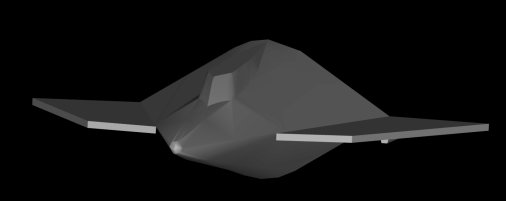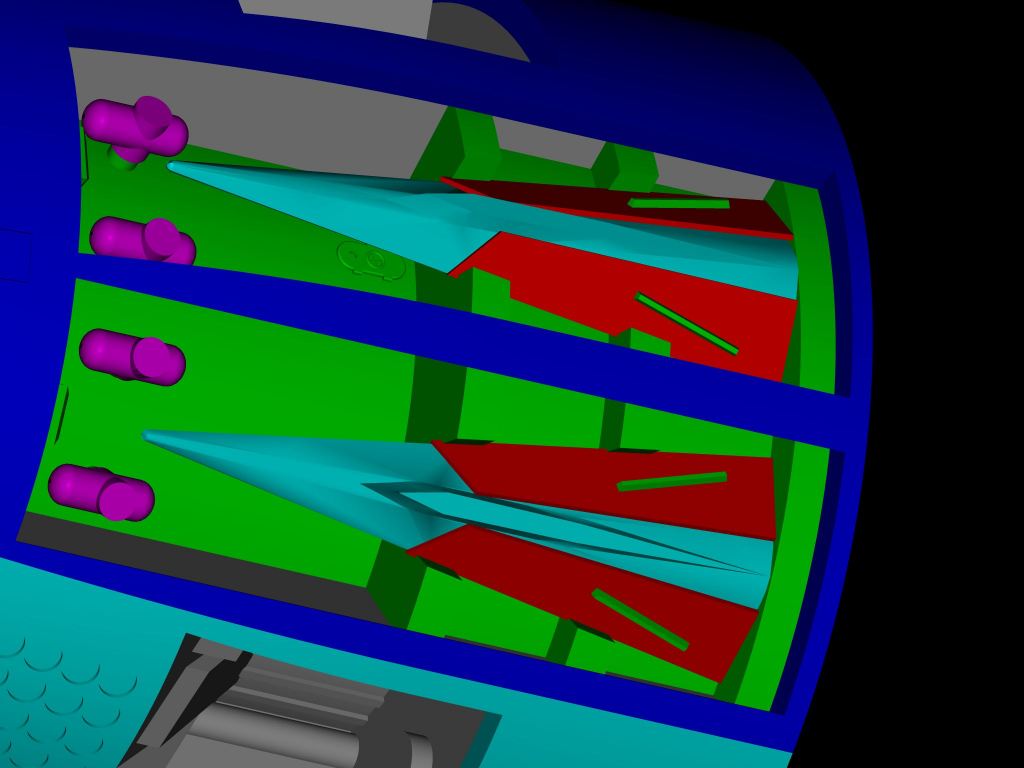The landing boats depicted in the new 1/288 scale Orion “Battleship” model are not pure invention on my part. But sadly, neither are they reconstructed from clear blueprints. They are the result of some deduction and detection and educated reconstruction.
First off, they were described to me by one of the actual Orion engineers as being about the size of a PT boat, and seating about 20. Additionally, they were “diamond shaped,” and used an extended skid during re-entry. The diamond shape part was a bit of a head scratcher, as I could not get further clarification on exactly what that meant (there were some communication difficulties). So, I looked through the open literature from the late 50’s/very early 60’s to see if I could find something from the NACA, USAF or Convair/General Dynamics that would fit the bill. I found a few, starting with this one:
And another from the NACA that looked more promising:
I went with the latter design as the basis for the landing boat for the CAD model of the Battleship that I put together for issue V2N2 of Aerospace Projects Review (go here and buy a copy, ya mooches).
As for the re-entry shielding skid, that was confusing until I was directed to this snippet from the December 1960 issue of Flying Review:
Not much I could really do with that, though.
As so often happens, once the product is out the door, more information comes in. In this case, I was put in contact with one of the artists employed by General Atomic Back In The Day (see HERE for more discussion of the long-lost Time Of Quality Aerospace Artwork), and it happens that he illustrated the landing boat. Sadly, the art seems to have been stuffed down the memory hole… but a single photo of his desk at the time remains, and on his desk was a painting of the landing boat:
No better resolution of that photo is available. The landing boat is on the far right. The other two paintings supposedly illustrate some other aspects of the Orion program, but there’s not enough visible to make heads or tails of ’em other than they seem to be in Earth orbit. An enlargement of the landing boat:
This clearly shows a head-on view of the boat. This verifies the “diamond shape,” at least as far as the cross-section of the craft. Also visible is a raised canopy, discrete wings, tricycle landing gear and a braking chute. As it turns out, the first NACA re-entry shape I’d looked at and passed over was closer to the correct shape.
Something about the wings bothered me. At last I recalled that I had seen something very like them before… in a Convair Astronautics Division Project Apollo proposal from 1961. Keep in mind, at the time General Atomic, like Convair, was a division of General Dynamics… and the two divisions were separated by only a few miles. It’s thus quite likely that re-entry vehicle design work at Convair was fed to General Atomic. Here, an advanced Apollo system was briefly discussed that would use a lifting body for the command module, a lifting body with stowed wings that seem to be the spitting image of those shown on the landing boat painting.
And so I took the “diamond shaped” front view, the NACA RV work, and the 1961 Apollo wings, and built from them a Landing Boat.
Ta-Da…
26 Responses to “About the “Landing Boats””
Sorry, the comment form is closed at this time.














That sure looks like the thing in the painting.
That’s a really interesting approach to the deployable wings; I don’t think I’ve ever seen it used before.
It should be very stable during the deployment phase as it could transition from the belly-flop reentry to horizontal flight gradually as speed dropped without overstressing the wings.
…Using the term “size of a PT boat” brings the following scary image to mind:
Cpt. McHale “HOLY COW! Chuck, you didn’t just fire off all those missiles!”
Ens. Parker: “Um, well, gee Skip, I could have sworn that switch was for the cigarette lighter!”
Gruber: “Boy, is old Leadbottom going to hit the roof when he sees those fireworks!
I have in my collection a NASA paper (TN-D-940: Lenticular vehicle landing characteristics) which uses folding wings as an essential element. Wasn’t there a Boeing proposal with folding wings?
What’s the basis for the retractable heat shield? Is that an aerospike that’s a bit larger than usual?
Moving parts have worried me since the bushings went out on the door to my Vega.
I was wondering about the landing vehicles. Fascinating information.
And I pulled the trigger and ordered a Orion Battleship resin model kit. This is going to be great! (I already have purchased a copy of V2N2, which is a bargain price considering all the great information contained)
this new Landing Boat is so cool
THX scott
Mike the Collector Said:
“I have in my collection a NASA paper (TN-D-940: Lenticular vehicle landing characteristics) which uses folding wings as an essential element.”
On that design they flipped up like on SpaceShipOne, didn’t they?
I must admit that I prefer your original boat design. The re-do version looks like the “Icarus” from _Planet of the Apes_. Still, excellent detective work!
You know, the Soviets under Andrei Sakharov designed a nuclear pulse powered spacecraft as well… maybe a Soviet nuclear space battleship is needed next: http://nukleus.istu.edu/raketa6.html
Click on the lowest word (“Majiee”) on the screen.
These landing boats remind me of the cutters from Niven and Pournelle’s THE MOTE IN GOD’S EYE.
In which novel the battlecruiser MacArthur is based on the plastic model Leif Ericson.
http://www.projectrho.com/SSC/model.html#misc
According to the image showing the Orion Battleship model pieces along side a ruler, the landing boats are about two and one-eight inches long. Which would fit in the hangar of the newly re-released Leif Ericson plastic model.
http://www.round2models.com/models/amt/ufo-mystery-ship
The fins on the NASA lenticular wind tunnel models folded over the back half of the craft. Not at all parallel to the direction of travel: the hinge line was about 40 degrees off the centerline of the vehicle.
Winchell Chung said:
“In which novel the battlecruiser MacArthur is based on the plastic model Leif Ericson.
http://www.projectrho.com/SSC/model.html#misc”
You might be interested in this model someone built of it based on info that Larry Niven gave at a talk about his spacecraft designs:
http://www.starshipmodeler.net/contest4/ss_s15.htm
Scott:
The “Folding” wing design is for an “Advanced-Apollo” concept?
What was the report number?
Appearantly the idea came back again as the basic mold-line seems to have been used in NASA Tech Memoradum X-656, dated 1963 for a “Boost-Glide Reentry Vehicle suitable for Operation as a Supersonic Aircraft”
I’m glad you posted this as I was having a HELL of a time judging the prospective for the LB illustrations since for some reason my mental “optical” sensor was insisting that the folding “wings” were attached to the top and bottom of the vehicle :o)
Reading the above mentioned report it seems they (Ames Research Center in this case) did some pretty intensive testing for the proposal at Supersonic, Transonic, and subsonic speeds.
Interestingly enough I’d already pointed out (somewhere :o) that the concept would be close to what the Marines are looking for as the “Hot-Eagle” landing boat.
Randy
As for the Lenticular RV design:
Georgia Tech “revivied” the concept as a possible “orbital” tourism vehicle launched by the Falcon-V a couple of years ago. It had almost the entire upper surface “glazed” with windows since the LRV design didn’t experiance significant heating along the top surfaces both due to the design and the “wings” being folded over the windows on launch and entry.
The “Planet-of-the-Apes” Icarus-like shape:
Scott the “core” design DOES look an awful lot like something based on an older “Spacecruiser” concept. Was there any work prior to the SC proposal for such a hypersonic shape with the majority of the “life-supported” section towards the rear of the vehicle?
In the SC concept the “manned” portion was towards the rear and the fuel up front to avoid the issue of launching with the pilot in a “head-down” position, but I understand that it was later found that the position was less sensitive to consumable mass changes.
Randy
Just for fun, I drew the NACA version using Google Sketchup, I like your new interpretation, though… so any thoughts on making this into a model, Scott?
Rick, did you use Sketchup on the vehicle in TN-D-940?
I got my Orion Battleship in the mail today! It’s great!
And yes, the landing craft fit quite nicely into the Leif Ericson’s landing bay.
http://yfrog.com/jaleiforionlanders2j
Nice! Looks like 3 would fit in there with alternating positioning.
General question: I seem to recall seeing a concept at some point and time for a “seaplane” type reentry vehicle similar to the Landing Boats described in the “Empire-of-Man” stories…
Anyone have a clue if there actually was such a thing or am I just mental?
(Well, YES I’m mental… 20 years of working Ammo will do that to you ;o)
Randy
I happen to own the paintings in the desk photo, i would be more than happy to share them with the forum.
The statements that the other photos are another aspect of “Orion” are incorrect, the painting at the left in the desk photo and the painting at the right are the same vehicle in different stages of its mission. It is believed that this vehicle is actually from the USAF “Man In Space Soonest” program. All of the paintings that I have are titled as “Apollo”. As you can see from my photo I have provided a painting that was not known before now. I am possibly going to be reproducing these artworks in poster form, if anyone is interested please contact me. jkb5@sbcglobal.net
> The statements that the other photos are another aspect of “Orion” are incorrect,
Except that Jim Bryant, the artist who painted these, told me specifically that they were done for Orion. The paintings may well have been re-used for other programs, or the designs themselves recycled.
I stand behind my statements, the serial number on the craft is the same in all three of my paintings.
Shrug. I tend to imagine that an artist who worked on the Orion program knew what he was talking about when he described his own artwork. According the Bryant, the three paintings depict a test version of the Orion landing boat being put through it’s paces from launch to re-entry to landing. He didn’t know where the “Apollo” came from, and assumed that someone scribbled that on there at a later date. Note that the landing boats do share design features with an actual Apollo configuration, illustrated above.
February 10
At the first meeting of the House Committee on Science and Astronautics, during the first session of the 87th Congress, Charles F. Ducander, Executive Director and Chief Counsel of the Committee staff, outlined a number of proposed subjects for study. One subject was the Air Force’s interest in a three-man spacecraft similar to the Apollo spacecraft planned by NASA. A Committee staff member had been assigned to investigate this duplication of effort. On February 22, testifying before the Committee, Air Force Undersecretary Joseph V. Charyk stated that the Dyna-Soar program was a direct approach to manned military space applications. The Air Force interest in an Apollo-type spacecraft was part of the post-Dyna- Soar program, Charyk said.
U.S. Congress, House, Committee on Science and Astronautics, Miscellaneous Committee Business, 87th Congress, 1st Session (1961), p. 6; U.S. Congress, House, Committee on Science and Astronautics, Research and Development for Defense, 87th Congress, 1st Session (1961), p. 161.
The above was taken directly from information on the NASA “Apollo” documentation found on the internet. The USAF was interested in pursuing a “Apollo” program that paralleled NASA’s “Apollo” program. In the paintings that I have all of the vehicles in the paintings have “USAF” on them and all of the title sheets for each painting is titled as “Apollo” this or “Apollo” that depending on what is going on in the painting. All of the title sheets are signed by J. Bryant and titled by the same.
> All of the title sheets are signed by J. Bryant
Yes, the same guy who told me directly and specifically that these paintings were done WRT Orion.
Once again, the fact that they were done for Orion – remember, he worked for General Atomic at the time – does not mean that they weren’t “re-tasked” for Apollo.
Would your “landing boat” need an “Atlas” rocket attached to it for and reason?
Yes. The Atlas was to boost a prototype version of the landing boat on a suborbital test flight, flying a similar mission to the sub-orbital (pre-Titan III) Dyna Soar spaceplanes. Note that as designed here, this booster would *not* be capable of putting the landing boat (or Apollo, if you like) into a good orbit, only suborbitally. To get to orbit, the spaceplane would need something substantially bigger… in the case of Apollo, some variant of the Saturn C-1 would likely be needed just for orbit, never mind lunar flight. The landing boat is roughly the same size as the Dyna Soar, which the Atlas-Centaur could *not* put into orbit; the much larger Titan III was needed. The Atlas booster shown in the landing boat art has a heavier upper stage due to fairing, as well as what *appears* to be only a single engine on the second stage.
Note also that the design of the landing boat was described by David Weiss well before Jim Bryant confirmed these paintings. The description matched the paintings, so I was in direct contact with two Orioneers who confirmed the role of this design.